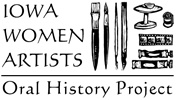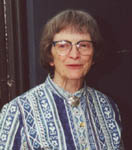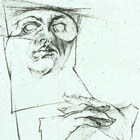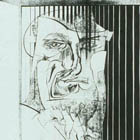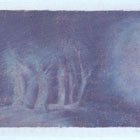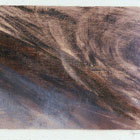VIRGINIA A. MYERS
artwork | audio | book | first-person narrative
artwork
audio 
(see also Making Art in Iowa and Art & Spirituality)
- Growing up (44sec. | 301KB): listen | read
- Early choice (60sec. | 409KB): listen | read
- Process (37sec. | 256KB): listen | read
- Developing (60sec. | 411KB): listen | read
- Aesthetic news (56sec. | 386KB): listen | read
- Grateful (43sec. | 296KB): listen | read
book
Foil Imaging: A New Art Form (2001)
an art book and functional teaching text establishing an aesthetic and technical foundation for a new art form. More than 250 2D and 3D art pieces are illustrated in color. Hardcover; by Virginia A. Myers and 48 foil artists.
audio text
Growing up
My dear mother, who had no art background but who realized the value of the cultural assets of a great town like Cleveland, took us—Sis and me—to Saturday morning art classes at the Cleveland Museum of Art. It was a great experience. And the classes were always over at twelve noon. And then Mom would meet us and take us to the restaurant. In the afternoon starting at two, there'd be a special program in the auditorium for kids. But there would always be about an hour between the time we would finish eating and that program, which we could wander the museum. Two o'clock would come, there we were at the auditorium. It was a whole Saturday occupation for my mother. So, that was a very important experience.
Early choice
In seventh grade, when I was forced to take a sewing class, I hated it! Make that stupid apron with two stripes on it, you know, and a tie in the back. And what were the boys taking? Woodshop—that's where I wanted to be. Early on, I wanted to be an artist. And I thought, "Well, you could get married." But I observed how hard my mother worked—the piles of ironing when everything had to be ironed, you know, and full time keeping the house, and how hard Dad worked to keep us in a good financial status. And I thought, "I can't do it." If I'm going to get married, of course, I want to have children—that's what marriage is about. And it isn't that I didn't like children. Heavens above, I spent fifteen summers in summer camp counseling and loved every minute of it. So it was an early choice. And to say that there hadn't been opportunities meanwhile along the way to get married, oh, yes! But, it wasn't part of what I thought was the plan.
Process
The process is exciting. When you cut a burin line, or a series of them, and it's just right, and you ink and wipe the plate, and you lift that damp print off of the plate, and it's just it—there's something wonderful that happens to you. Or with foil stamping, when you are overlaying foil and working through the layers—because foil stamping is a layered process—and you are seeing colors and textures emerge that you didn't dream of that are carrying your initial aesthetic drive into new orbits, that's heaven! And it's intoxicating, it really is! And it keeps you doing it.
Developing
I've found out that when you're alone, the great ideas can come out. That's why I don't allow radios in my classroom. I want you to hear yourself think. You have plenty of noise in the world; you don't need these distractions. I'm not always too popular—I'd rather have them hate me now, than five or six years and they get out, then they go, "Why didn't she teach me this?"
Begin to develop your priorities, and to seek out who you are, and not be afraid to think, "Oh, I don't have to be ‘normal.'" You have to know something before you can feel it, and then you have to know some ways of manifesting it. You have to be flexible, too. But you also have to be tough, and you just can't go along always with the crowd. You really can't. You'll suffer for it, but it isn't all suffering catfish either. The orbits in which a creative person operates are much wider than the average person.
Aesthetic news
You have to be in touch with the fact that you can produce something and you don't always know whether it's going to be good or bad. You don't stop to think of that, just make it! Do it! The real test, if you're a creative person, is that you do it not just when you're feeling good. Anybody can be creative when they're feeling good. But, do you do it when you're not feeling so good? And some of the days when you're not feeling well—I can speak from my own experience—some of the best things come out. You don't know! You don't know, until you go down and present yourself to your work table or your tools or whatever it is—your paintbrushes—say, "Well, here I am. I wonder what the grand aesthetic news from the interior is today!" And sometimes it's not very good, and sometimes it's wonderful, and sometimes it's in between. But the most important thing, after all, is that you were there today. And you tried.
Grateful
I'm just grateful to be here. I just feel extremely lucky. I think about it every day. I walk out there and look around. The other night, I was sitting out on the deck, and the stars had come out, you know, and I could see the planes going way up there—couldn't even hear them. There was the Big Dipper and the night sounds were in the woods, and I thought, Wow—this is something wonderful! I have no excuse not to do my work well. It's all right. So far, so good, if I can just keep things going. And if I can see the foil stamping business so that it really becomes a viable art form, well, to put it very succinctly, dying will not be so hard.
first-person narrative
Give Back the Best You Have
edited from interview | copyright © 2003–2026 Jane Robinette | All Rights Reserved
Early on, I wanted to be an artist. I observed how hard my mother worked—the piles of ironing, and full-time keeping the house, and how hard Dad worked to keep us in a good financial status. If I'm going to get married, of course, I want to have children—that's what marriage is about. I'd thought, I can't do it. It isn't that I didn't like children. Heavens above, I spent fifteen summers in summer camp counseling and I loved every minute of it. It was an early choice. And to say that there hadn't been opportunities meanwhile along the way to get married, oh, yes! But it wasn't part of what I thought was the plan.
Even now, I don't regret the choice. Of course, there's a measure of loneliness that goes along with this kind of thing. But one of the real proofs of a creative mind is that you can make something wonderful out of aspects of life that most people think are negatives. Most people don't want to be lonely—well, neither do I; that can get to you. On the other hand, it can also be usefully used. If you can learn to live alone, that's a real proving ground. I'm not recommending it to everybody, and I'm not saying that that's a panacea at all. It isn't. For some, it's the thing to do. I knew it was for me. I've found out that great things happen to me when I'm all alone. When you're alone, the great ideas can come out.
*
Mother was a very well-read person. My dear mother, who had no art background but who realized the value of the cultural assets of a great town like Cleveland, took Sis and me to Saturday morning art classes at the Cleveland Museum of Art. The classes were always over at twelve noon, and then Mom would meet us and take us to the restaurant in the museum. Then in the afternoon starting at two, there'd be a special program in the auditorium for kids. But there would always be about an hour between the time we would finish eating and that program, which we could wander the museum. It was a whole Saturday occupation for my mother. That was a very important experience.
Dad was very much an outdoors person. Even back in the days when Dad was teaching at Dartmouth, he'd put an Adirondack pack on his back, he'd take me by the hands, and we'd go to the woods and climb Velvet Rocks. Dad would identify all the plants and the trees. I'd get too tired, he'd pick me up and put me in the Adirondack pack and I'd peek out. So, I had an early start on being a woodsman.
*
My sister's interests were more typically feminine. She learned to knit and to sew well and to cook and these things. I veered away from them. In seventh grade, when I was forced to take a sewing class, I hated it! Woodshop—that's where I wanted to be, but at that time I wouldn't have stood a chance to be enrolled in that class instead of sewing and cooking.
It was Miss Ely, tenth and eleventh grade art, that started me on oil painting, which was what I wanted to do so badly. She gave me a list of colors and we weren't allowed to use the black for the first paintings; we weren't allowed to have it on the palette even—it was the old Impressionist thing coming through. She lived with Miss Corser who had taught me art in the ninth grade at Shaker High. They were working artists and they taught very good lessons.
Dad took a government job in Washington, D.C., and we moved there my senior year. In the first semester of my senior year I attended three different high schools. It was not fun. I was not the average high school person. I was not boy crazy; I avoided that. I dressed very plainly, because I didn't want to attract any attention. I think some of the plain jane characteristics are still with me. I was not looking forward to the idea of going to college, because high school was not pleasant. But Mom and Dad insisted, and by attending the George Washington University for the academics, I could also get academic credit for the studio art at the Corcoran School of Art. Those classes at the Corcoran were set up on an atelier basis, that is, on a studio basis. Each class met for three hours, five days a week. My undergraduate years were 1945 to 1949, and the vets came back, and it was an exceedingly lively time on that campus.
*
The Presbyterian Church USA had several mission stations in the West, and they offered me a job at the Tucson Indian Training School, Tucson, Arizona. Graduated in June. Early in September, I flew out to Tucson. What an adventure it was! It was grades seven through twelve, and it was a boarding school. It was really an interesting year, but it became quite evident that it was not the right place.
I needed to get back to the art. I had been painting as much as I could in the art room at night. But I wanted to get on with it, and I knew I couldn't afford to be a private studio. Well, you become a student again—California College of Arts and Crafts. I lived in with a family in Oakland, and I did housework, babysitting, and cooking. Didn't have much money. I was just thinking, How can I stay in art without getting a standard 9-to-5 job?
*
I decided to go to the University of Illinois, Urbana-Champaign, but I was a non-degree candidate. That was the time abstract impressionism was coming in—Jackson Pollock, Clifford Still. I did a few drip paintings—frankly, I was bored. It registered to me how important it was to be able to draw well. I wanted to continue drawing and painting and to take printmaking with Lee Chesney who was one of Lasansky's students.
I finished two years at the University of Illinois and I needed to move on. I talked to Chesney one day, and he said, "Virginia, if you really want to do printmaking, you should go to Iowa and study with Lasansky." I had no barbed-wire entanglements; no teen-aged marriages and kids. I don't mean to say that marriage is a barbed-wire entanglement, but for me, at that point it would have been. So I came to the campus; hadn't been admitted at all. Got off the old Rock Island, my suitcase, no place to live, no job, a little over $200 left over from summer camp salary. I can't remember the wrinkles of how I got into the university, but I did. I got my first year at Iowa doing exactly what I wanted—to study with Lasansky. I hardly had two cents beyond just enough to get me back up to summer camp in Vermont, but I wasn't a penny in debt, either. I've found out one great lesson: not being in debt is like having money.
I got a job as an advisor at Currier Hall for two years. By then was getting along pretty famously with Lasansky, so I was offered the job as his research assistant. I was really his confidential secretary, because although his English was okay, it wasn't sterling by a long shot, and he was doing a lot of correspondence. I did that until I wanted to go to Paris. I had been planning that for a long time. I had a brilliant undergraduate language major—I traded her prints and drawings for French lessons. I needed it for my application for a Fulbright, which I didn't get the first year I tried. But I got it the second year and went to Paris.
*
My application was to study with Stanley William Hayter at Atelier 17. He ought to be regarded as the granddaddy for the renaissance in the handmade print in the last part of this century. Hayter learned how to burin engrave from a Polish artist, Joseph Hecht. Pretty soon, Hayter had an intaglio press in his studio, and friends were coming in and seeing what he was doing. That was the beginning of his teaching atelier, except it wasn't always in Paris. During World War II, emigré artists from all over the world studied with him, and that's how Lasansky came to know him.
I remember writing to Lasansky. He had hinted that there might be a job here, but he's very cagey and careful, and I was never one to take anything for granted—never, ever. So I said, "I have information from the Fulbright Commission here in Paris that if I'm to apply for renewal, I need to do it within the next month and a half." That's all I said. Got a letter right back. "I want you to come back as an instructor."
I've been teaching now at Iowa since 1962, printmaking, and I've seen a lot of talent. A lot of them have come from Iowa; there's no lack of talent in this state, there's lack of opportunity. Fortunately, there are more museums now and there are more opportunities.
*
The artwork sprung from a very personal view of what is close to me. The Malfeasance series was a psychological thing that had to do with things that were happening to me with other people, and it was depicted in that manner. Landscape can be terribly trite and terribly benign and non-threatening. But living out here in the midst of Mother Nature, I see it from different angles. The important thing is the space and the light. And as I look at it, after your good health—mental and physical—and talent, whatever in the world that is, the two other things you need the most of are time and space. Of course, a little money to go along with it is okay, but I've never proceeded with a dollar sign in my eye.
One sometimes is driven by what you're innovating technically. The big innovation now is the foil stamping and the use of reflective surfaces in developing the aesthetics with myself and my students. The foil stamping is part of my destiny. It started in 1985—the invention began on May 2, 1986. The patent was May 7, 1991. Underwriters Laboratory Listing, January 7, 1998. That's a big chunk out of my total life span, but I'm well equipped to do it.
Before you can have a new art form—well, we had to have the tool first, the Iowa Foil Printer, but if you don't have a sound aesthetic and technical foundation, you're nowhere. That's what we've been building. But it doesn't mean that I'm just forever, always doing foil stamping. I do paint. Color's a great, great concern with foil stamping, and I like my students to be good as draftspeople and as painters. They're farther ahead than people who are not. But in terms of art, I like to try projects that I'm not sure I can handle; I like to take the chances.
The process is exciting. When you cut a burin line, or a series of them, and it's just right, and you ink and wipe the plate, and you lift that damp print off of the plate—there's something wonderful that happens to you. Or with foil stamping, when you are overlaying foil and working through the layers—because foil stamping is a layered process—and you are seeing colors and textures emerge that you didn't dream of that are carrying your initial aesthetic drive into new orbits, that's heaven! It's intoxicating, it really is! And it keeps you doing it.
*
I've seen hundreds and hundreds of exceedingly talented artists emerge from our program here, and they're not doing it anymore. I keep telling them, "The real test, if you're a creative person, is that you do it not just when you're feeling good. Anybody can be creative when they're feeling good." Some of the days when you're not feeling well—I can speak from my own experience—some of the best things come out. You don't know, until you go down and present yourself to your work table or your tools—say, "Well, here I am. I wonder what the grand aesthetic news from the interior is today!" Sometimes it's not very good, and sometimes it's wonderful, and sometimes it's in between. But the most important thing, after all, is that you were there today. And you tried. There are times when you are extra inspired, but this idea of, "well, I have to wait for inspiration"—it's a bunch of nonsense. People who do that are not going to make much.
*
I could've lived anywhere. I chose Iowa because basically I am a farmer and a woodsman, and I need to be close to the soil and the trees. Everybody says, "Oh, Iowa's such a conservative state." But all these years they have still supported the arts, and the state universities where art is offered, on a regular basis. We always want more money, but then that's not uncommon just for artists—all the departments always want more money. But we've been sustained, so it makes a good statement about the people who live here.
To be a full professor at a great research-oriented university—it's the only place in this world that the initiative like the foil stamping could take place. A business would never, could never, without doing a market survey, go through the invention process without knowing whether it's going to sell. We're just now getting into the manufacturing mode. We still don't know how much market there's going to be for it. I'd be deeply in debt on the invention if it hadn't been for Betty Stanley. Other money comes out of my pocket—that salary check comes, boy, how much can I cut out? How much do I need to live on? Not that much, not that much. I didn't have my first car until I was in my mid-forties! My Toyota Four Runner, which is in the garage, is only the second car. My first one was a Checker Marathon station wagon, 1970. I had it for twenty-two-and-a-half years. I rode a bicycle, saved like crazy! So, the priorities have been the thing. It's a lifestyle that I've developed to suit my idea about what I can give back, and I can give back some rather good things. I may not be the best artist that the world has ever seen, probably not. But I can tell you one thing—I'm not the worst one either.
*
One of the parts of growing up and maturing is to find out who you are and what are the things that you could do that will help you to give back the best that you have. Because what you have, nobody else has—not now, or ever will have—and if you don't give it back now, it'll be lost. So give it your best shot, and don't be judging about whether it's so great or so bad—forget that. Just do it as best you can, and be thankful and grateful every day that you are lucky to be born here in America and not someplace else where women are disdained.
Learn to draw. If you're going to go on and do the visual arts, learn to paint—you need to learn to have color. But first, History of Western Civ.; then follow up with history of art, art appreciation. And travel. Begin to develop your priorities and to seek out who you are. The last thing you want to be is a stereotype. On the other hand, you don't want to be such an oddball that you're way out in some orbit that's never going to relate to earth.
You need to know people and you need to know history, and you need to know what's going on—or what will you have to say in your art? You have to know something before you can feel it, and then you have to know some ways of manifesting it. Let the "how-to" follow what you want to do. And you determine that in terms of observing other people, listening to what other people say, and beginning to identify more closely how it suits you. Basically, is it the correct direction? And what seems a correct direction at one stage may prove incorrect later on, so it means that you have to be flexible, too. But you also have to be tough, and you just can't go along always with the crowd. You'll suffer for it, but it isn't all suffering catfish either.
It's very nice to have in your bag of tricks a wide range of possibilities, so that when the aesthetic need calls, you can reach in and you can get something. Which, of course, is what happened to the reflective surface. I wanted to do landscapes where the light would change. I didn't have a mirror surface and I needed it, and that's the important thing. Artists now are hanging it on virtuoso techniques, and this is getting to be very true of the computer. I'm not here to suggest that computer imaging can't be beautiful. I'm just here to suggest, though, that those people who cannot draw and are using a computer, they don't have as good eyes—that's what drawing is! That's why it should be taught in elementary school, because you learn to use your eyes—you learn to see more. And because you see more, there's more richness, there's more to react to, there's more to utilize in what you are trying to do, whether it's visual or dance or whatever.
*
The orbits in which a creative person operates are much wider than the average person. So when you're feeling good, oh, it's super good! And when you're feeling bad, it's terrible! It's not in-between here. But everything you do, it's based on how much you believe; the product is the proof of how deep your beliefs were. Sure, you have doubts. But if the doubts become stronger than your belief, you won't do it! It takes a lot of courage to transcend that sometimes. You just have to grit your teeth. But ultimately there is something good that's going to come out of this. Good is not defined here necessarily as something that may be pleasant, but it's a piece of me that if I don't manifest it in a tangible form, nobody will ever see it. They won't be able to learn from me the way I have learned from all those who have gone before me, and on whose shoulders I am now standing. That's what history is about!
*
I'm just grateful to be here. I feel extremely lucky. The other night, I was sitting out on the deck and the stars had come out, and there was the Big Dipper and the night sounds were in the woods, and I thought, Wow—this is something wonderful! I have no excuse not to do my work well. And when I'm not doing it, do you understand how the conscience comes up and slaps me? I feel very guilty. But as long as the work goes on and it goes forward, it's okay; you need this space, you need the peace and the quiet and the solitude.
Wouldn't I love to retire? Oh, you bet! But the foil-stamping job is not done—my work at the university is not complete yet. I need to see it established there in the new art building. I need to see a space that's just for foil stamping. Otherwise, it might not happen. If I can just keep things going, and if I can see the foil stamping business so that it really becomes a viable art form, well, to put it very succinctly, dying will not be so hard.
